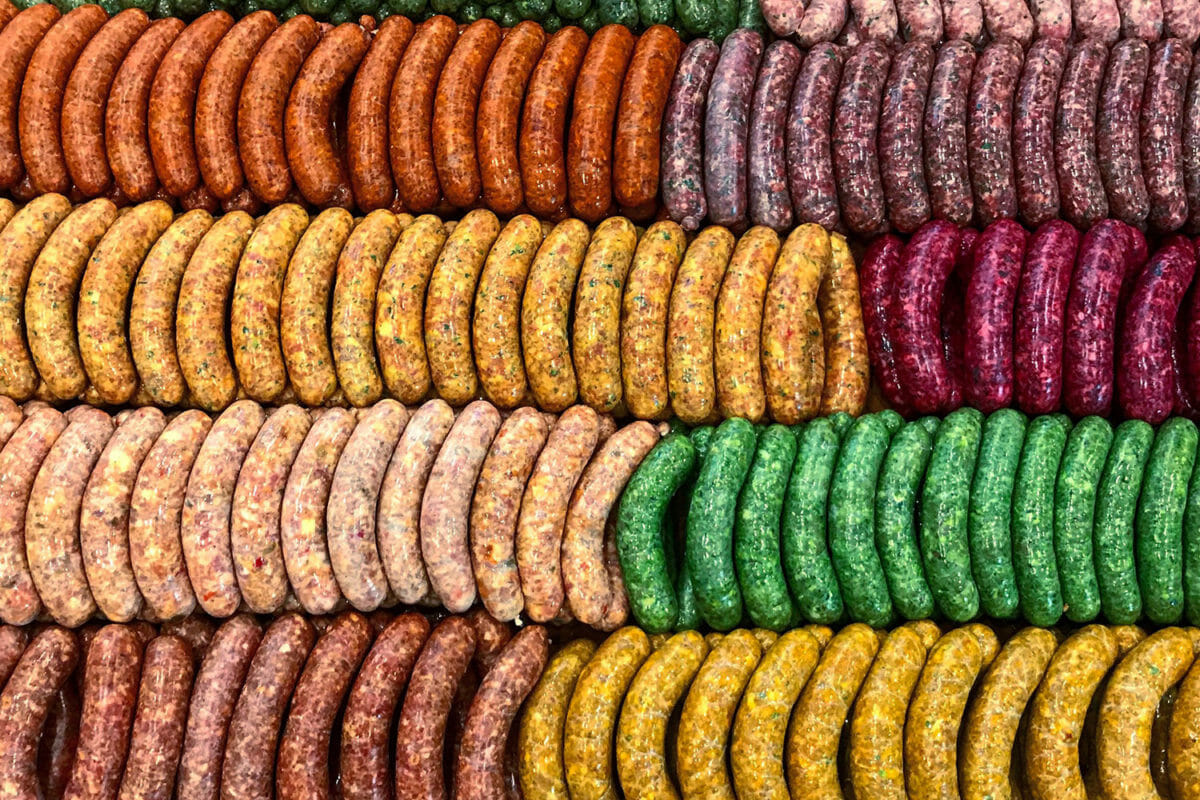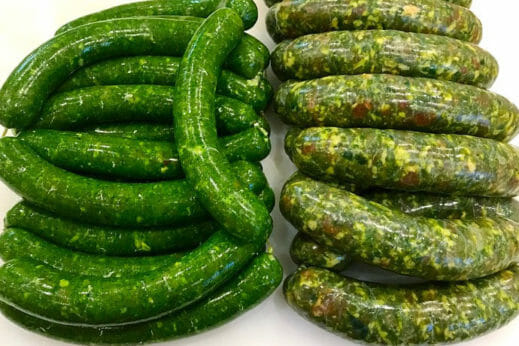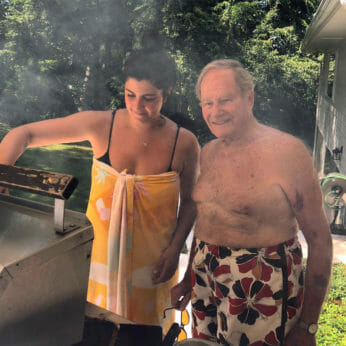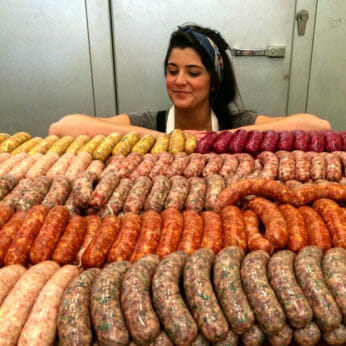How Cara Nicoletti’s Sausage Is Made: Hard Work…and Lots of Veggies
What happens when a butcher isn’t much of a meat-eater? These colorful, flavorful, veggie-packed sausages.
How Cara Nicoletti’s Sausage Is Made: Hard Work…and Lots of Veggies
What happens when a butcher isn’t much of a meat-eater? These colorful, flavorful, veggie-packed sausages.

Cara Nicoletti grew up in a butcher shop, but when she eventually took up the family trade, she put a decidedly personal twist on the art.Cara Nicoletti
“I’m one of those people constantly panicking and saying ‘Why are you not doing more and what are you even doing, you loser?’” Nicoletti says with a laugh, as if becoming a well-known food personality, cookbook author, baker, butcher, and host of “The Hangover Show” on Vice Munchies is the career path of a slacker. “That’s just days when my brain is being super mean. That’s something I’m working on this year, being nicer to myself.”
While her brain might play tricks on her, Nicoletti is plenty nice. She’s also rip-smart and, at a very young age, is a major influence on the culinary world. Having grown up in family butcher shops in Massachusetts (Nicoletti’s great-great-grandfather and great grandfather started as butchers in the Ukraine before they fled to the U.S. during the Holocaust) and later apprenticing at The Meat Hook, one of New York’s premier butcher institutions, she quickly began to develop her own take on the trade.
“It’s about the time and care that goes into raising one good animal that makes you think of it as more of a luxury than necessity.”
See, nowadays this butcher doesn’t actually eat a lot of meat (grains, veggies, fish and “so many herbs” are her day-to-day sustenance). The reason is simple: as the daughter of butchers, Nicoletti admits that vegetables were MIA in her life until she started working in restaurants – and now she’s doing her sneaky part to get everyone eating more vegetables as well.
“My feelings about meat and eating meat changed a lot when I started going to the farms that provided our cattle and sheep, and the slaughterhouses,” explains Nicoletti, adding that to her, “It’s about the time and care that goes into raising one good animal that makes you think of it as more of a luxury than necessity.”.

The young butcher’s attitude could, perhaps counterintuitively, be summed as such: Let’s chill out a bit with the meat-guzzling mentality.
“Most people my age – and my customers – are trying to figure out ways to get more vegetables into our food,” Nicoletti explains. “It’s also a way to make our meat go further.”
To achieve this goal, Nicoletti creates beautiful, tasty, vegetable-and-herb-spiked links in (nearly) every color of the rainbow, currently showing off her links at Foster Sundry in Brooklyn. But if you’re thinking cheese and parsley or apple chicken sausage type mixes, think again. That’s bush league. To make these veggie-laced, brightly-colored sausages, Nicoletti takes some of her favorite dishes – maybe a soup (matzoh ball or pho, perhaps?), a sandwich (Philly roast pork? Banh mi?), or even a full entree (like borscht, or chicken tikka masala) – and then gets to work combining meats, veggies, herbs, and seasonings to R&D said dish into a sausage (a process that involves eating said meal in non-sausage form many, many times).

The results of this alchemy is as beautiful as it is delicious. Nicoletti’s beet-bombed borscht sausage is nuclear blood red, all thanks to the veggie. Spinach chlorophyll gives a radiant green tint into other varieties. There’s quite a bit of testing (and a lot of fails) that go into recipe development, mostly because veggies = moisture = the bane of sausage making. Just because you like a dish doesn’t mean it will sausage, one example being a Reuben sandwich sausage catastrophe that haunts Cara’s dreams.
Vivid colors and sausage may not necessarily sound… appetizing, but one glance at Cara’s Instagram and you’ll understand why she’s earned more than 20,000 followers. Let’s set the record straight, though: This isn’t the “unicorn latte” of the sausage world or any such nonsense concoction designed simply for quick ‘gram thrills.
“I do think that sometimes people look at my sausages or my Instagram and think I’m adding dyes or doing it as a gimmick. Really, the truth is the colors happen because of the recipes and amount of produce I use,” explains the butcher. “It was never like ‘I want to make these super-colorful sausages’ – it was a really exciting byproduct and customers buy with their eye. They’re going to buy a bright pink sausage filled with beets over an Italian sausage, and that makes me happy. They really do taste good, and that’s first and foremost.”

Another side-effect of IG fame? Lots of strangers trying to slide into the woman’s DMs (and presumably lots of ill-advised sausage jokes).
“My entire DM box is butchers asking for my recipes. It’s like no, you cannot. Work harder and figure it out on your own. There’s a lot of people who want to get into food and butchering, and I can always sense when it’s because they want to have an interesting Instagram – those are the ones who don’t last long, once they realize the job is kind of shitty.”
And those quitters aren’t wrong. It is a shitty job.
“My grandpa did not want us doing this,” Nicoletti reflects. “When I was kid, I always thought it was because I was a girl, and he didn’t want to pass it on to women. But it’s because it’s a really fucking hard job and he wanted more for us.
Years later, when she was 22 or so, the aroma of blood and sawdust drew Nicoletti back into a butcher shop after stints cooking and baking in restaurants. Grandpa was not happy. But once the initial shock wore off, it became a point of pride and grandpa-granddaughter bonding. “It’s been an amazing thing for our relationship,” Cara beams. “I don’t think I would have found this path for myself if it hadn’t been something that was in my family.”
Follow us
This work is licensed under a Creative Commons Attribution-NoDerivatives 4.0 International License.
Want to republish a Modern Farmer story?
We are happy for Modern Farmer stories to be shared, and encourage you to republish our articles for your audience. When doing so, we ask that you follow these guidelines:
Please credit us and our writers
For the author byline, please use “Author Name, Modern Farmer.” At the top of our stories, if on the web, please include this text and link: “This story was originally published by Modern Farmer.”
Please make sure to include a link back to either our home page or the article URL.
At the bottom of the story, please include the following text:
“Modern Farmer is a nonprofit initiative dedicated to raising awareness and catalyzing action at the intersection of food, agriculture, and society. Read more at <link>Modern Farmer</link>.”
Use our widget
We’d like to be able to track our stories, so we ask that if you republish our content, you do so using our widget (located on the left hand side of the article). The HTML code has a built-in tracker that tells us the data and domain where the story was published, as well as view counts.
Check the image requirements
It’s your responsibility to confirm you're licensed to republish images in our articles. Some images, such as those from commercial providers, don't allow their images to be republished without permission or payment. Copyright terms are generally listed in the image caption and attribution. You are welcome to omit our images or substitute with your own. Charts and interactive graphics follow the same rules.
Don’t change too much. Or, ask us first.
Articles must be republished in their entirety. It’s okay to change references to time (“today” to “yesterday”) or location (“Iowa City, IA” to “here”). But please keep everything else the same.
If you feel strongly that a more material edit needs to be made, get in touch with us at [email protected]. We’re happy to discuss it with the original author, but we must have prior approval for changes before publication.
Special cases
Extracts. You may run the first few lines or paragraphs of the article and then say: “Read the full article at Modern Farmer” with a link back to the original article.
Quotes. You may quote authors provided you include a link back to the article URL.
Translations. These require writer approval. To inquire about translation of a Modern Farmer article, contact us at [email protected]
Signed consent / copyright release forms. These are not required, provided you are following these guidelines.
Print. Articles can be republished in print under these same rules, with the exception that you do not need to include the links.
Tag us
When sharing the story on social media, please tag us using the following: - Twitter (@ModFarm) - Facebook (@ModernFarmerMedia) - Instagram (@modfarm)
Use our content respectfully
Modern Farmer is a nonprofit and as such we share our content for free and in good faith in order to reach new audiences. Respectfully,
No selling ads against our stories. It’s okay to put our stories on pages with ads.
Don’t republish our material wholesale, or automatically; you need to select stories to be republished individually.
You have no rights to sell, license, syndicate, or otherwise represent yourself as the authorized owner of our material to any third parties. This means that you cannot actively publish or submit our work for syndication to third party platforms or apps like Apple News or Google News. We understand that publishers cannot fully control when certain third parties automatically summarize or crawl content from publishers’ own sites.
Keep in touch
We want to hear from you if you love Modern Farmer content, have a collaboration idea, or anything else to share. As a nonprofit outlet, we work in service of our community and are always open to comments, feedback, and ideas. Contact us at [email protected].by Mike Hess, Modern Farmer
September 21, 2018
Modern Farmer Weekly
Solutions Hub
Innovations, ideas and inspiration. Actionable solutions for a resilient food system.
ExploreExplore other topics
Share With Us
We want to hear from Modern Farmer readers who have thoughtful commentary, actionable solutions, or helpful ideas to share.
SubmitNecessary cookies are absolutely essential for the website to function properly. This category only includes cookies that ensures basic functionalities and security features of the website. These cookies do not store any personal information.
Any cookies that may not be particularly necessary for the website to function and are used specifically to collect user personal data via analytics, ads, other embedded contents are termed as non-necessary cookies.